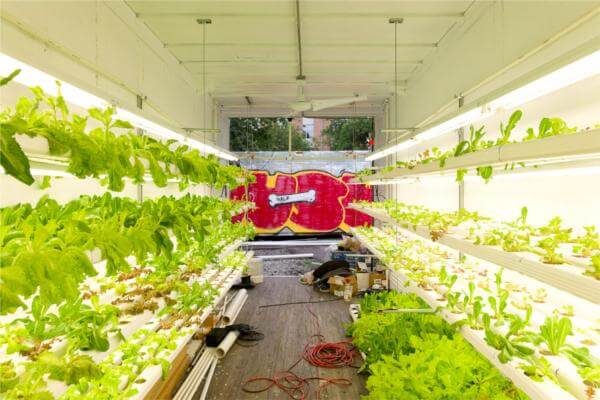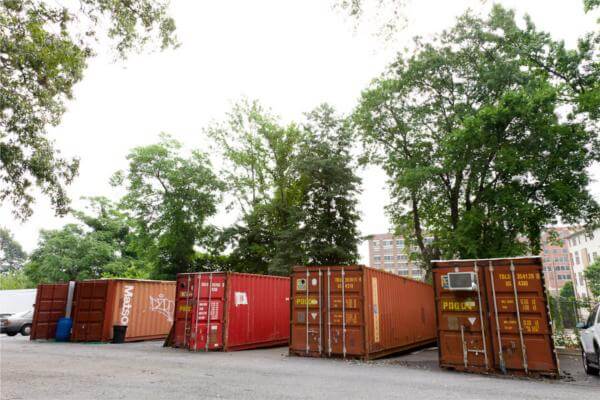Three Modular Urban Farming Companies to Watch:
———————————————————————————————————
Check out this video about Podponics, a company that converts shipping containers into controlled environment agriculture. They claim that one container can grow the equivalent of an acre of open field agriculture. They are not the only company on the block doing this FreightFarms and Growtainer are also in the business of modular high density farming. Modular urban farming solutions are less expensive, flexible, and scalable. Keep an eye on this growing trend.
1. A Podponics Shipping Container Farm

For those familiar with hydroponic farming techniques, PodPonics is pretty much what you’d expect. An old shipping container is retrofitted with up to five tiers of growing platforms where beds of lettuce are grown with their roots in water, not soil. Nutrients are added as needed, and banks of LED lights shine overhead. From here, PodPonics starts to innovate. They’ve added monitors for temperature, humidity, pH, and carbon dioxide levels so that these variables can be optimized for maximum growing potential. Many factors can be adjusted remotely using an iPhone interface. Their LED lights can change spectrum slightly over the course of day to stimulate different growing phases in the plants. You want the right combination of factors at the right time to produce the best lettuce. And that’s what PodPonics does for ten different leafy greens like arugula, cressida, and watercress.
Dan Backhaus was able to give more details about the startup costs of PodPonics’ production. The shipping containers they use (either 40, 48, of 53 feet long) cost between $1800 to $2800 depending on size and condition. While containers can be stacked up to 10 high, logistically it makes more sense to keep it below four for maintenance access reasons (PodPonics doesn’t stack any of their containers at the moment). This means that a 50′x10′ footprint may serve to grow ~4 acres worth of produce. That will make real estate costs feasible in most cities, though not all. PodPonics is still getting a firm idea on how much it will cost to retrofit each container once they are bought. The first pod they ever made was basically produced with materials you could find at Home Depot. Now, PodPonics is talking with companies to build partnerships for injection molded parts, more versatile (and efficient) LED lights, etc, etc. While it’s still very early to know the finalized cost of pod production, Backhaus ball-parked it near $20k. Not cheap, certainly, but well within the budgets of many cities and even non-profits looking to improve urban communities.
With their latest round of funding (again, about $725k), PodPonics is essentially making two big moves. The first is a literal relocation, moving to the Hartsfield Jackson Atlanta International Airport and constructing 16 pods. At that location PodPonics will be just two miles from the Forest Park produce terminal – the single largest distribution center for produce in the region. With 16 pods, PodPonics should be able to show that their plans are scalable and able to take advantage of any unused urban land.

———————————————————————————————————
2. Rendering of the “Growtainer” from Green Tech Agriculture

We are developers of INVESTMENT GRADE INDOOR FARMING PROJECTS ! Controlled Environment Agriculture provides perfect measures of HVAC (heating, ventilation and air conditioning), light, CO2, water and nutrition for optimum production. Increased yield in a shorter time ! Watch the video below to see The Growtainer. This is it ! Grow anything ! Anywhere !
———————————————————————————————————
3. FreightFarms Also provide modular urban farming containers

Freight Farms produce big results for the local market.The state-of-the-art production technologies optimize the harvest cycle for any grower and puts food supply within everyone’s reach. The human centered design benefits a wide variety of users, including but not limited to; institutional foodservice providers, schools, restaurants, farmers, grocery stores, disaster relief efforts, wholesale produce distributors and developing communities. Freight Farms can be operated with minimal training and equipped with technology to optimize workflow. Users can monitor the unit remotely and control every element of the system from their mobile devices. Harvest support services are available for customers looking to maximize their growing potential.
———————————————————————————————————
Why go Modular?
When designing a system synthetically (such as an electronic machinery, a biological enzyme or a building), the system could be designed by two broad ways. The first way would be to design the complete system using the known theories, and use the system, as it is designed, in the real conditions. An alternative way would be to design the different components of the system separately, and test each component in separate conditions. Modular design, or “modularity in design”, is an approach that subdivides a system into smaller parts (modules) that can be independently created and then used in different systems to drive multiple functionalities. A modular system can be characterized by the following:
- (1) Functional partitioning into discrete scalable, reusable modules consisting of isolated, self-contained functional elements
- (2) Rigorous use of well-defined modular interfaces, including object-oriented descriptions of module functionality
- (3) Ease of change to achieve technology transparency and, to the extent possible, make use of industry standards for key interfaces.
